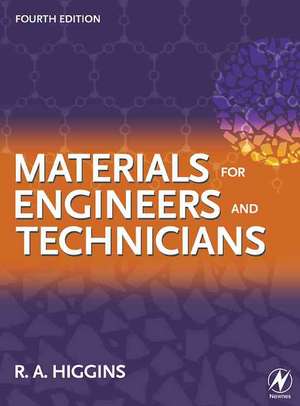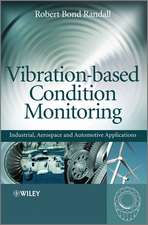Materials for Engineers and Technicians
Autor R. A. Higginsen Limba Engleză Paperback – 10 ian 2006
Avoiding the excessive technical jargon and mathematical complexity so often found in textbooks for this subject, and retaining the practical down-to-earth approach for which this book is noted, Materials for Engineers and Technicians is now thoroughly updated and fully in line with current syllabus requirements.
Offering a comprehensive guide to materials used by engineers, their applications and selection in a single volume, the fourth edition focuses on applications and selection – reflecting the increased emphasis on this aspect of materials engineering now seen within current vocational and university courses. Materials properties and relevance to particular uses are addressed in detail from the outset, with all subsequent chapters linking back to these essential concepts. Detailed discussion of examples of materials, and additional applications of processes have been incorporated throughout the text, with expanded sections addressing the causes of failure as this relates to material selection. Updated sections in the fourth edition provide a wider ranging discussion of titanium, printed-circuit-board materials and production, silicon chip production, and the applications and forms of modern composite materials.
This new edition has been matched closely to the relevant units of the BTEC Higher National Engineering program, as well as catering fully for the requirements of a Level 3 audience. Students of BTEC Nationals will find that the new edition structure covers all the essential topics required for their courses in the early chapters (chapters 1 – 8). Those students following higher level qualifications (HNC / D Engineering, and first year undergraduate Engineering Materials modules within Mechanical, Manufacturing Systems and also Electrical & Electronic Engineering degree courses) will find additional more advanced topics are addressed in the second half of the book.
In addition to meeting the requirements of vocational and undergraduate engineering syllabuses, this text will also prove a valuable desktop reference for professional engineers working in product design, who require a quick source of information on materials and manufacturing processes.
* Established and renowned text, now completely restructured to match current BTEC National and Higher National syllabus specifications
* New edition provides greater emphasis on materials selection, with a new chapter outlining material properties and their relevance to a variety of uses, reflecting current FE and HE course requirements
* Avoids excessive technical jargon and mathematical complexity common in textbooks for this subject
Preț: 179.16 lei
Nou
Puncte Express: 269
Preț estimativ în valută:
34.29€ • 35.70$ • 28.98£
34.29€ • 35.70$ • 28.98£
Carte tipărită la comandă
Livrare economică 28 februarie-14 martie
Preluare comenzi: 021 569.72.76
Specificații
ISBN-13: 9780750668507
ISBN-10: 0750668504
Pagini: 416
Ilustrații: Approx. 250 illustrations
Dimensiuni: 195 x 264 mm
Greutate: 0.19 kg
Ediția:4
Editura: Elsevier Science
ISBN-10: 0750668504
Pagini: 416
Ilustrații: Approx. 250 illustrations
Dimensiuni: 195 x 264 mm
Greutate: 0.19 kg
Ediția:4
Editura: Elsevier Science
Public țintă
Level 3 students on BTEC National Engineering programmes (NC and ND); Level 4 / 5 students on BTEC Higher National Engineering programmes (HNC and HND)– relevance to all routes.
First year undergraduates taking engineering materials modules within the degree courses such as:
Computer-Aided Mechanical Engineering; Mechanical-Electronic Systems Engineering; Manufacturing Systems Engineering; Electrical & Electronic Engineering; Electrical Power Engineering; Civil Engineering.
Cuprins
Engineering materials; Properties of materials; Mechanical testing; The crystal structure of metals; Casting process; Mechanical deformation of metals; The mechanical shaping of metals; Alloys; Equilibrium diagrams; Practical microscopy; Iron and steel; The heat-treatment of plain-carbon steels; Alloy steels; The surface hardening of steels; Cast iron; Copper and its alloys; Aluminium and its alloys; Other non-ferrous metals and their alloys; Plastics materials and rubbers; Properties of plastics; Ceramics; Glasses; Composite materials; Fiber-reinforced composite materials; Methods of joining materials; Causes of failure; Choice of materials and processes; Appendix: Properties of engineering materials; Index.
Recenzii
“This is an amazing book! No matter which discipline an engineer or technician is trained in, I am sure that he will learn much from it.”
— Brian Ellis, Circuit World
— Brian Ellis, Circuit World






